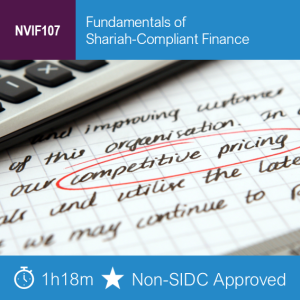Islamic Finance Essentials 7 Sep 2020 (Kuala Lumpur, Malaysia)
RM1,000.00 Original price was: RM1,000.00.RM558.00Current price is: RM558.00.
Training programme covering the principles of a Shariah-based monetary economy and its effects on the characteristics and nature of Islamic capital market products and the issues that arise
Description
Course Outline
Part A Section 1: Outline the Shariah and the Shariah-based economy (i) Brief history of Islam (ii) Stages of life according to Islam (iii) Islam encourages a balance in pursuits (iv) Objectives of the Shariah (v) Branches of Shariah (vi) Sources of jurisprudence – Quran, tradition, consensus and analogy (vii) Islamic economic philosophy (viii) Objectives of the Islamic economic system (ix) Ownership rights in Islam (x) Overview of Islamic contract and commercial laws
Part A Section 2: Contrast the Shariah-based monetary economy against the conventional monetary economy (i) Overview of conventional vs Islamic economics (ii) Permissible types of markets in Islam (iii) Roles of land, labour and capital in Islamic economics (iv) Focus of growth on the real economy vs nominal economy (v) Social justice and equity in Islamic economics (vi) Personal, community and national pursuits and equality of opportunity (vii) Mobilisation of privately-owned and publicly-owned resources (viii) Role of government in the real and monetary economy
Part A Section 3: Describe the framework for financial intermediation and financial products that complies with the Shariah (i) Nature and characteristics of money (ii) Money supply and demand (iii) Money as mentioned in the Quran and sunnah (iv) Role of money in Islam (v) Trade, barter and finance (vi) History of banking (vii) Business of banking and fractional reserve banking (viii) Money in the context of financial intermediation (ix) Overview of how financial markets work (x) Islamic finance framework (xi) Public finance and crowdfunding
Part A Section 4: Explain the specific criteria for financial and capital market products to comply with the Shariah-based framework (i) Trade and interest (ii) Excessive uncertainty (iii) Gambling (iv) Unlawful activities and commingling between lawful and unlawful activities (v) Sale of debt (vi) Options (vii) Multiple roles of parties in a transaction (viii) Legal and judicial structure that rule on Shariah compliance e.g. NSAC, Bank Negara Malaysia, Securities Commission, Islamic Financial Services Board, Accounting and Auditing Organization for Islamic Financial Institutions, parliament and courts
Part B Section 1: Outline the broad categories of characteristics for Islamic capital market products and services (i) Activities for which payment is permissible (ii) Types of trade (iii) Concept of risk and reward (iv) Surplus and deficit units in an economy and their psychology and behaviour (v) Concept of capital preservation (vi) Fixed income investors (vii) Investors who expect high return variable income
Part B Section 2: Describe the specific characteristics of Islamic capital market products and services (i) Bai bithaman ajil (ii) Bai inah (iii) Istisna’ (iv) Murabahah (v) Tawarruq (vi) Musawwamah (vii) Salam (viii) Musharakah (ix) Mudharabah (x) Stocks (xi) Ijarah (xii) Kafalah (xiii) Rahn (xiv) Takaful (xv) Qard (xvi) Wadiah (xvii) Diagrammatical illustration
Part B Section 3: Explain the issues arising from the characteristics of Islamic capital market products and services (i) Guarantee on income (ii) Sale of debt (iii) Leasing of undeveloped land (iv) Parallel transactions between the same parties (v) Floating rate mechanism (vi) Floating rate benchmark (vii) Documentation completeness and sequence (viii) Purchase undertaking and price setting
Part C Section 1: Describe the diversity of Islamic capital market products around the world compared with conventional capital market products (i) Global Islamic capital markets (ii) Investment community and financial intermediaries (iii) Islamic liquidity pool (iv) Incentives vs market-driven initiatives (v) Current status of Shariah principles (vi) Shariah-compliant and non-compliant stocks (vii) Kafalah, guarantee, takaful and rahn (viii) Matching businesses to principle (ix) Regulatory and market developments
Part C Section 2: Compare and contrast specific Islamic and conventional capital market products and services (i) Structuring conventional vs Islamic capital market products (ii) Terminology and salient terms (iii) Contrast in documentation and wording (iv) Role of the parties (v) Underlying assets (vi) Risk sharing vs risk transfer (vii) Profit and loss sharing (viii) Ceiling rate mechanism (ix) Events of default (x) Penalty payments (xi) Credit considerations (xii) Landmark cases with credit implications
Part C Section 3: Discuss proposing Islamic vs conventional capital market products for the following cases (i) Working capital for an engineering consultancy (ii) Investment in subsidiaries (iii) Power plant project (iv) Retail mall development (v) Cross-border investment (vi) Profit rate swap
You must be logged in to post a review.
Related products
-
-
Sale!
Islamic Finance Essentials 22 June 2020 (Kuala Lumpur, Malaysia)
RM1,000.00Original price was: RM1,000.00.RM558.00Current price is: RM558.00. -
Sale!
Islamic Finance Essentials 10 March 2020 (Kuala Lumpur, Malaysia)
RM1,000.00Original price was: RM1,000.00.RM498.00Current price is: RM498.00. -
Sale!
Islamic Finance Essentials 4 May 2020 (Kuala Lumpur, Malaysia)
RM1,000.00Original price was: RM1,000.00.RM558.00Current price is: RM558.00.




Reviews
There are no reviews yet.